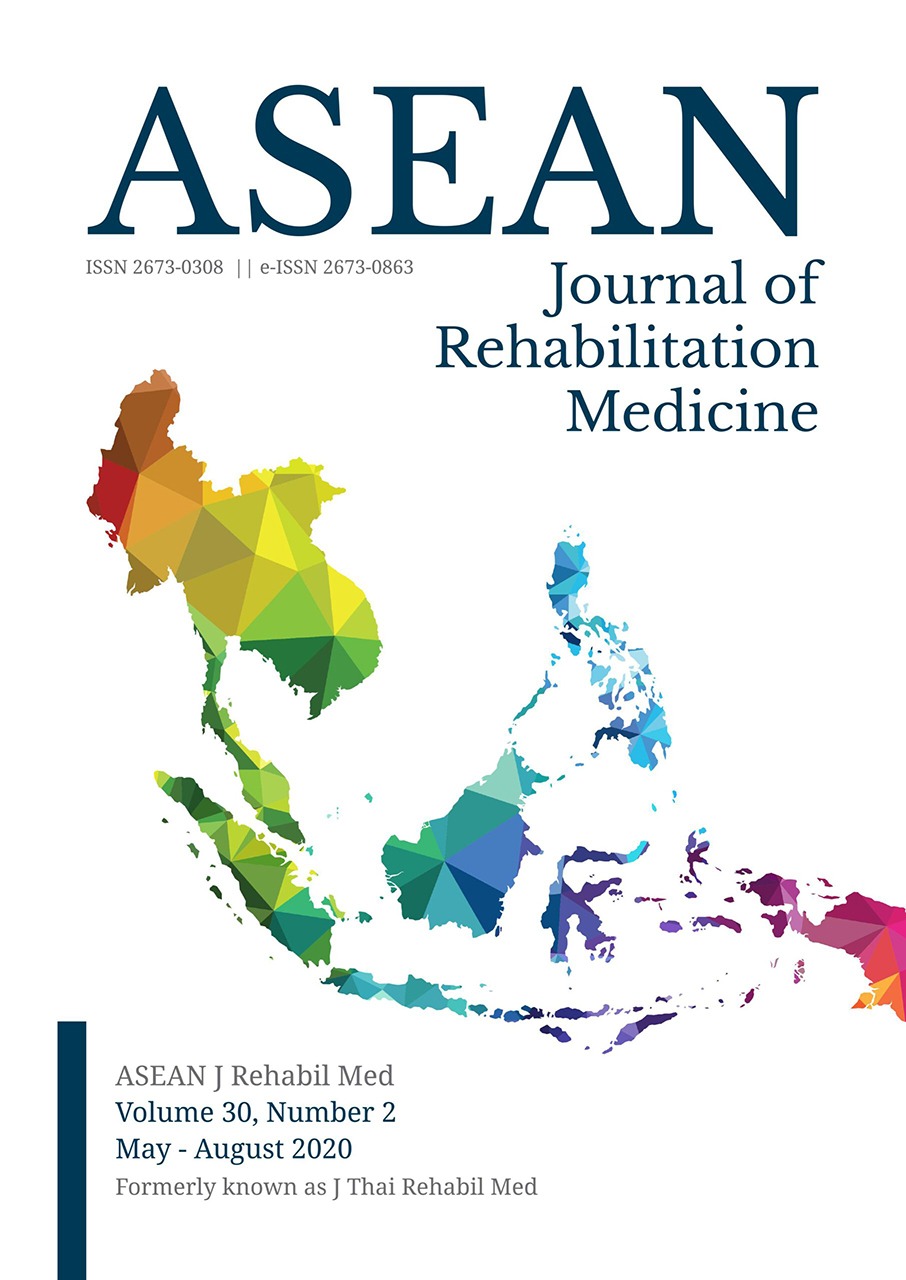Negative Effects of Betahistine on Recovery of Brainstem Oculo motor Integration after Vestibular Rehabilitation of Benign Paroxysmal Positional Vertigo (BPPV) Patients
Keywords:
vestibular rehabilitation, physical therapy, benign paroxysmal positional vertigo, vestibulo-ocular reflex, betahistineAbstract
Objectives: To evaluate effects of betahistine, an antihistamine, on recovery of vestibulo-ocular functions in patients with BPPV after vestibular rehabilitation (VR) therapy.
Study design: Retrospective study.
Setting: Vestibular Rehabilitation Clinic, Division of Physical Therapy, Department of Rehabilitation Medicine, Trang Hospital, Ministry of Public Health, Trang, Thailand.
Subjects: Patients with BPPV who were referred for VR; assessed with global BPPV symptom severity visual analog scale (VAS), Dix-Hallpike test (DHT), roll test (RT), head thrust test (HTT), and gaze evoked nystagmus test (GENT) before once a week of VR and one week after completing three sessions; and performed a daily home-based VR exercises (VREs) for 3 or 4 weeks.
Methods: Data of all assessments mentioned above were extracted from case record forms, and divided into two groups: those taking betahistine (81 patients) and those not taking any antihistamine (84 patients). Data from the two groups were compared and analyzed.
Results: After completing all three sessions of VR therapy, every assessment score significantly decreased (p < 0.001) in both groups. Before the first therapy, mean VAS scores (SD) of the betahistine and the no antihistamine groups were 9.12 (0.73) and 9.22 (0.70), respectively (p = 0.38); in the second assessment, were 4.17 (0.86) and 5.15 (1.21) respectively (p < 0.001); in the third assessment, were 3.53 (0.63) and 2.57 (3.32) (p < 0.001), and in the last assessment, were 1.84 (0.64) and 0.03 (0.18) respectively (p < 0.001). Regarding the baseline assessment of the DHT, the RT, the GENT, and the HTT, there were no significant differences (p > 0.01) between the two groups. However, in all subsequent assessments there were significant differences in the GENT and the HTT scores between the two groups, favoring to the no antihistamine group over the betahistine group (p < 0.01). The DHT and the RT scores did not reach significant differences between the two groups in the last two weeks of assessments.
Conclusion: Once a week of VR therapy and a daily home-based VREs for three or four weeks significantly decreased the BPPV symptoms. Recovery of vestibulo-ocular reflex function seemed less and not as complete in those taking betahistine.
References
Messina A, Casani AP, Manfrin M, Guidetti G. Italian survey on benign paroxysmal positional vertigo. Acta Otorhinolaryngol Ital. 2017;37:328-35.
Argaet EC, Bradshaw AP, Welgampola MS. Benign positional vertigo, its diagnosis, treatment and mimics. Clin Neurophysiol Pract. 2019;4:97-111.
Balatsouras DG, Koukoutsis G, Fassolis A, Moukos A, Apris A. Benign paroxysmal positional vertigo in the elderly: current insights. Clin Interv Aging. 2018;13:2251-66.
Yazıcı A, İnanç Y. Evaluation of BPPV with vertebral artery values. Neuropsychiatr Dis Treat. 2018;14:1975-9.
Zaag-Loonen HV, Bruintjes T, Leeuwen RV. Probable benign paroxysmal positional vertigo converts into definite BPPV in one in six patients. J Int Adv Otol. 2018;14:456-8.
Giannini S, Signorini L, Bonanome L, Severino M, Corpaci F, Cielo A.Benign paroxysmal positional vertigo (BPPV): it may occur after dental implantology: a mini topical review. Eur Rev Med Pharmacol Sci. 2015;19:3543-7.
Von Brevern M, Bertholon P, Brandt T, Fife T, Imai T, Nuti D, et al. Benign paroxysmal positional vertigo: diagnostic criteria consensus document of the Committee for the Classification of Vestibular Disorders of the Bárány Society. Acta Otorrinolaringol Esp. 2017; 8:349-60.
Edlow JA, Gurley KL, Newman-Toker DE. A new diagnostic approach to the adult patient with acute dizziness. J Emerg Med. 2018;54:469-83.
Pérez-Vázquez P, Franco-Gutiérrez V. Treatment of benign paroxysmal positional vertigo: a clinical review. J Otol. 2017;12:165-73.
Bressi F, Vella P, Casale M, Moffa A, Sabatino L, Lopez MA, et al. Vestibular rehabilitation in benign paroxysmal positional vertigo: reality or fiction? Int J Immunopathol Pharmacol. 2017;30:113-22.
Rodrigues DL, Ledesma ALL, de Oliveira CAP, Bahamad Júnior F. Physical therapy for posterior and horizontal canal benign paroxysmal positional vertigo: long-term effect and recurrence: asystematic review. Int Arch Otorhinolaryngol. 2018;22:455-9.
Spiegel R, Rust H, Baumann T, Friedrich H, Sutter R, Göldlin M, et al. Treatment of dizziness: an interdisciplinary update. Swiss Med Wkly. 2017;27:147: w14566.
Bergquist F, Dutia MB. Central histaminergic modulation of vestibular function - a review. Acta Physiologica Sinica. 2006,58:293-304.
Muncie HL, Sirmans SM, James E. Dizziness: approach to evaluation and management. Am Fam Physician. 2017;95:154-62.
Lee SH, Kim JS. Benign paroxysmal positional vertigo. J Clin Neurol. 2010;6:51-63.
Tayati W. A comparative study of physiotherapy treatment in patients with BPPV symptoms treated with and without medication. Presented at the 7th Thailand Physical Therapy Conference, 2015 June 23-26; Bangkok, Thailand.
Wu P, Cao W, Hu Y, Li H. Effects of vestibular rehabilitation, with or without betahistine, on managing residual dizziness after successful repositioning maneuvers in patients with benign paroxysmal positional vertigo: a protocol for a randomized controlled trial. BMJ Open. 2019;9:e026711. http://dx.doi.org/10.1136/bmjopen-2018-026711






